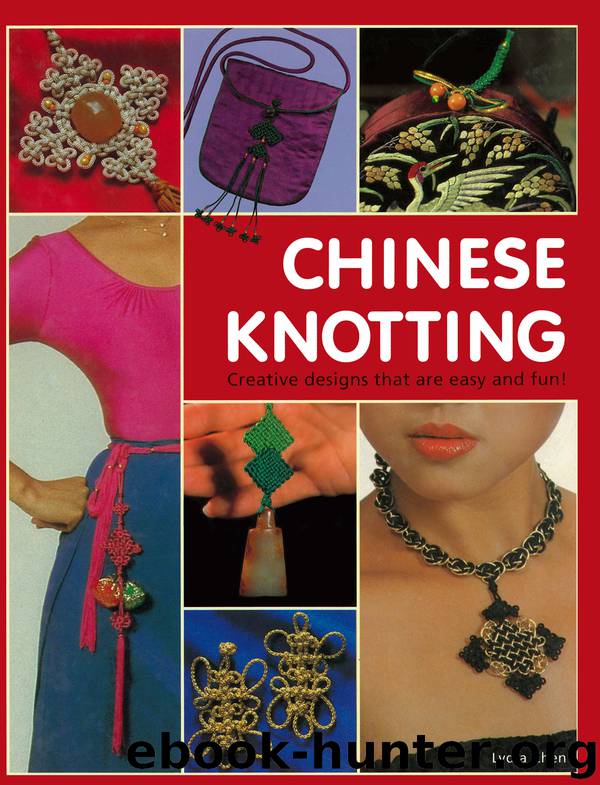Chinese Knotting by Lydia Chen

Author:Lydia Chen
Language: eng
Format: epub
ISBN: 0-8048-3399-0
Publisher: Tuttle Publishing
≪TYING PROCESS≫
dragon knot
DRAGONFLY KNOT
The dragonfly, though it does not have a rich mythological heritage, has fascinated young and old throughout the ages in China. Children tax their wits to snare them, even chanting a ditty to lure males toward a captive dragonfly maiden. Dragonflies, noted for their speed and agility, can often be seen flittering to and fro near ponds and streams in search of food. Their capricious, erratic flight and the beauty of their lacy wings and orb-like eyes have earned them a special place in the hearts of Chinese artists and poets. Perhaps the artists felt a tinge of envy as they watched the dragonfly’s flight, wishing to rid themselves of the constraints of daily intercourse and taste the pleasures of playful abandon.
TYING
Use two cords, tying them as if they were one, to begin the dragonfly knot. First, tie a button knot to serve as the head. After tightening, tie a sauvastika knot just below it. The loops will come out of the sides to form two pairs of wings. Then, use the outer two cord ends to tie a series of flat knots around the inner two to make the body.
HINTS
• Don’t let the two cords twist around each other, or your dragonfly’s wings will not lie flat.
• If you clip off one of the inner cord ends about halfway down the desired length of the body, the series of flat knots will taper, and form a more lifelike dragonfly.
Download
This site does not store any files on its server. We only index and link to content provided by other sites. Please contact the content providers to delete copyright contents if any and email us, we'll remove relevant links or contents immediately.
| Advertising | Annuals |
| Book Design | Branding & Logo Design |
| Fashion Design | Illustration |
| Science Illustration |
Wonder by R.J. Palacio(8432)
Mastering Adobe Animate 2023 - Third Edition by Joseph Labrecque(3722)
Unlabel: Selling You Without Selling Out by Marc Ecko(3575)
Ogilvy on Advertising by David Ogilvy(3486)
Hidden Persuasion: 33 psychological influence techniques in advertising by Marc Andrews & Matthijs van Leeuwen & Rick van Baaren(3456)
Drawing Cutting Edge Anatomy by Christopher Hart(3440)
The Pixar Touch by David A. Price(3349)
POP by Steven Heller(3298)
The Code Book by Simon Singh(3058)
The Art of War Visualized by Jessica Hagy(2932)
Slugfest by Reed Tucker(2924)
The Curated Closet by Anuschka Rees(2899)
Rapid Viz: A New Method for the Rapid Visualization of Ideas by Kurt Hanks & Larry Belliston(2816)
Stacked Decks by The Rotenberg Collection(2796)
365 Days of Wonder by R.J. Palacio(2739)
The Wardrobe Wakeup by Lois Joy Johnson(2720)
Keep Going by Austin Kleon(2683)
Tattoo Art by Doralba Picerno(2585)
Tell Me More by Kelly Corrigan(2579)
